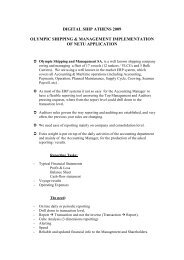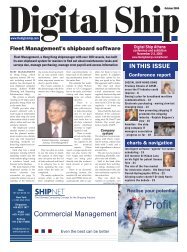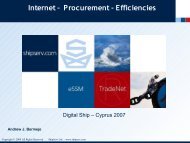Torm Shipping chooses VSAT for entire fleet - Digital Ship
Torm Shipping chooses VSAT for entire fleet - Digital Ship
Torm Shipping chooses VSAT for entire fleet - Digital Ship
You also want an ePaper? Increase the reach of your titles
YUMPU automatically turns print PDFs into web optimized ePapers that Google loves.
SATCOMS<br />
A<br />
s part of the final push to bring full<br />
global coverage <strong>for</strong> its high-speed<br />
FleetBroadband service, Inmarsat<br />
has planned a repositioning schedule <strong>for</strong> its<br />
constellation of Inmarsat-4 (I-4) satellites<br />
that aims to close the current hole over the<br />
Pacific Ocean and optimise the network<br />
going <strong>for</strong>ward over the next decade.<br />
The repositioning programme will also<br />
necessitate service outages <strong>for</strong> users of<br />
FleetBroadband in certain regions of the<br />
world <strong>for</strong> up to 25 days, as coverage disappears<br />
while the spacecraft travel to their<br />
new homes.<br />
While this may be inconvenient <strong>for</strong><br />
some broadband users, Inmarsat says<br />
that the measure is a necessary result of<br />
the evolution of the broadband family of<br />
products (including land mobile BGAN<br />
and SwiftBroadband aeronautical services),<br />
and is designed to improve per<strong>for</strong>mance<br />
<strong>for</strong> all users once complete.<br />
"The whole I-4 portfolio business case<br />
has changed dramatically from the time we<br />
decided to build the satellites," explains<br />
Richard Denny, Inmarsat's vice president,<br />
satellite and network operations. "It's a situation<br />
that's been evolving <strong>for</strong> eight years<br />
now. We signed the contract to build the<br />
satellites in 2000 and at that time<br />
FleetBroadband wasn't even intended."<br />
"BGAN was originally designed to be a<br />
land product, and we built three satellites<br />
in case one didn't make it up there, as you<br />
can cover 86 per cent of the world’s land<br />
mass and 98 per cent of the population<br />
with two satellites in their current location.<br />
But once the programme got underway<br />
we saw that there were all sorts of<br />
opportunities to develop these capabilities<br />
in the maritime and aeronautical sectors,<br />
which weren't in the original plan."<br />
Inmarsat satellite repositioning<br />
In preparation <strong>for</strong> global coverage of FleetBroadband in 2009, Inmarsat is about to embark on a satellite<br />
repositioning programme that will involve service outages in different regions during January and February.<br />
<strong>Digital</strong> <strong>Ship</strong> spoke to Richard Denny and Piers Cunningham, Inmarsat, to find out more<br />
"To do that, firstly we'd need three<br />
satellites, so we needed two successful<br />
launches <strong>for</strong> the first two. After that happened<br />
it meant a whole new way of thinking,<br />
developing the FleetBroadband and<br />
SwiftBroadband services, and optimising<br />
the network on a global basis <strong>for</strong> these<br />
products. The repositioning is one of the<br />
elements that came out of the whole<br />
review of these capabilities."<br />
With the three-satellite fully-global network<br />
a possibility following the successful<br />
launch of the third satellite in August of<br />
this year, Inmarsat then began to look at<br />
how to organise the new constellation to<br />
achieve maximum per<strong>for</strong>mance <strong>for</strong> all<br />
users, on land and at sea.<br />
"(Repositioning) gives us benefits on<br />
the whole portfolio of the I-4 satellites,"<br />
explained Mr Denny. "Land is at the heart<br />
of it, but there are benefits <strong>for</strong> the other<br />
services, like FleetBroadband."<br />
"We can achieve a better global optimisation<br />
of all of our satellites because of the<br />
way that the spectrum gets utilised<br />
around the world, so we can actually have<br />
increasing capacity as a result of this. That<br />
will benefit the maritime sector, they will<br />
have more capacity in the future."<br />
"One of the problems we have <strong>for</strong> land at<br />
the moment is that mountain ranges and so<br />
on can get in the way, as people at the edge<br />
of coverage tend to be at a lower elevation.<br />
FleetBroadband already has the advantage<br />
that ships on the oceans don't have anything<br />
in the way in terms of visibility to the satellite,<br />
so that doesn't really affect maritime,<br />
but this will also allow us to optimise the<br />
total broadband portfolio <strong>for</strong> the end users."<br />
Mr Denny is keen to point out that the<br />
company has not taken the decision to<br />
move these satellites, and the subsequent<br />
<strong>Digital</strong> <strong>Ship</strong> December 2008 page 12<br />
service outages, lightly, and is convinced<br />
that the benefits will be worth the ef<strong>for</strong>t.<br />
"When we first mooted the idea of<br />
repositioning the I-4s the automatic<br />
response was 'why do you want to do<br />
that?', but there were historical reasons <strong>for</strong><br />
positioning the satellites where they were<br />
in 2005, and in 2008 we have a whole different<br />
way of looking at the global delivery<br />
of broadband services. It's been very<br />
much an evolutionary process," he said.<br />
Piers Cunningham, head of maritime at<br />
Inmarsat, notes that the evolving nature of<br />
the industry over the past few years has<br />
necessitated this acceleration in plans <strong>for</strong> a<br />
maritime broadband service, which were<br />
barely conceived when the development<br />
of these I-4 satellites first began.<br />
"At that point we hadn't even launched<br />
Fleet into the market, so it shows what<br />
kind of crystal ball you need, in the market,"<br />
he told us.<br />
"The maritime terminals are unaffected<br />
by the relocation of the satellites, they're<br />
type approved down to the edge of coverage<br />
so whether the satellite is over land or<br />
the oceanic areas, to a maritime terminal it<br />
makes no difference at all. But optimising<br />
the overall architecture is important, the<br />
whole idea is that it will benefit everyone."<br />
Schedule<br />
Getting to grips with the Inmarsat schedule<br />
<strong>for</strong> the repositioning takes a little patience,<br />
and a good memory <strong>for</strong> codes and acronyms.<br />
The key elements are the I-4, or<br />
Inmarsat-4, satellites. The I-4s are Inmarsat's<br />
latest generation of technology, and have<br />
joined the Inmarsat-3 (I-3) and Inmarsat 2 (I-<br />
2) generations in orbit above the Earth. The<br />
I-4s are the satellites that are required to<br />
operate the FleetBroadband network.<br />
A FleetBroadband service outage will occur in the red shaded area from January 7 2009, <strong>for</strong> 25 days<br />
Three I-4 satellites are now circling the<br />
planet, with Flight 1 (F1) launched in<br />
March 2005, Flight 2 (F2) launched in<br />
November 2005, and Flight 3 (F3) entering<br />
orbit in August of 2008.<br />
The I-4 F1 and the I-4 F2 have been carrying<br />
FleetBroadband traffic within their<br />
own footprints since the service was<br />
launched in November 2007, and will,<br />
after repositioning, be joined by the I-4 F3<br />
to offer global coverage <strong>for</strong> the first time.<br />
These satellites have also been utilised, to<br />
a small extent, by existing legacy services,<br />
such as Fleet and mini-M.<br />
The planned repositioning will also mean<br />
a re-definition of the traditional Inmarsat<br />
ocean regions covered by the three satellites.<br />
Currently, the two active I-4 satellites<br />
are the I-4 F1 in the Indian Ocean Region<br />
(IOR) and the I-4 F2 in the Atlantic Ocean<br />
Region West (AOR-W), with I-4 F3 having<br />
recently been launched and completed<br />
testing be<strong>for</strong>e being situated above the<br />
Americas at 98°W.<br />
Following repositioning, I-4 F1 will<br />
hence<strong>for</strong>th offer coverage over the Asia-<br />
Pacific region (ASIA-PAC), I-4 F2 will cover<br />
Europe, the Middle East and Africa (EMEA),<br />
and the I-4 F3 will remain positioned over<br />
North and South America, covering their<br />
surrounding oceans (AMERICAS).<br />
It is in this shift in regions that service<br />
gaps will appear, starting in January 2009,<br />
Mr Denny explains.<br />
"On the seventh of January we'll be<br />
transferring all of the E&E (existing and<br />
evolved) services, things like Fleet 77, 55<br />
and 33, mini-M, these types of services.<br />
They'll all be coming off the I-4 (F2) and<br />
going onto I-3 F4 (one of Inmarsat's previous-generation<br />
satellites)," he told us.<br />
"Once we've got all of the traffic off the<br />
satellite we start it on its way, and this is<br />
when we'll have the first service outage, to<br />
take it (I-4 F2) to its new home over EMEA."<br />
All FleetBroadband traffic, which cannot<br />
be carried by the I-3 generation of satellites,<br />
will be moved onto I-4 F3 (AMERICAS) -<br />
which is situated to the west of I-4 F2, thus<br />
leaving a coverage gap over the westernmost<br />
part of Africa, and areas of the<br />
Atlantic from north to south including<br />
Ireland, Iceland and north-western UK (see<br />
red shaded area in diagram, left).<br />
"At that point of time the I-4 F3 satellite<br />
will be providing BGAN and<br />
FleetBroadband services, and the IOR (I-4<br />
F1) will be running as it is at the moment,"<br />
said Mr Denny.<br />
"From the current coverage provided by<br />
the AOR-West satellite, the only area that will<br />
lose coverage is the red shaded area (previous<br />
page), while we're moving the satellite to<br />
its new home. That area will go without<br />
FleetBroadband coverage <strong>for</strong> about 25 days,<br />
starting from the seventh of January."<br />
As soon as the first satellite has been successfully<br />
repositioned Inmarsat will then<br />
begin its second scheduled relocation, and<br />
the final part in the network jigsaw.<br />
"The next outage occurs from the sixth
















